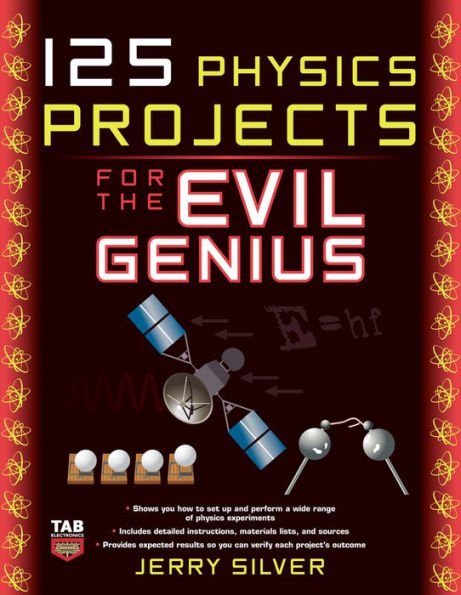125 Wickedly Fun Ways to Test the Laws of Physics!
Now you can prove your knowledge of physics without expending a lot of energy. 125 Physics Projects for the Evil Genius is filled with hands-on explorations into key areas of this fascinating field. Best of all, these experiments can be performed without a formal lab, a large budget, or years of technical experience!
Using easy-to-find parts and tools, this do-it-yourself guide offers a wide variety of physics experiments you can accomplish on your own. Topics covered include motion, gravity, energy, sound, light, heat, electricity, and more. Each of the projects in this unique guide includes parameters, a detailed methodology, expected results, and an explanation of why the experiment works. 125 Physics Projects for the Evil Genius:
- Features step-by-step instructions for 125 challenging and fun physics experiments, complete with helpful illustrations
- Allows you to customize each experiment for your purposes
- Includes details on the underlying principles behind each experiment
- Removes the frustration factor--all required parts are listed, along with sources
125 Physics Projects for the Evil Genius provides you with all of the information you need to demonstrate:
- Constant velocity
- Circular motion and centripetal force
- Gravitational acceleration
- Newton's laws of motion
- Energy and momentum
- The wave properties of sound
- Refraction, reflection, and the speed of light
- Thermal expansion and absolute zero
- Electrostatic force, resistance, and magnetic levitation
- The earth's magnetic field
- The size of a photon, the charge of an electron, and the photoelectric effect
- And more
125 Wickedly Fun Ways to Test the Laws of Physics!
Now you can prove your knowledge of physics without expending a lot of energy. 125 Physics Projects for the Evil Genius is filled with hands-on explorations into key areas of this fascinating field. Best of all, these experiments can be performed without a formal lab, a large budget, or years of technical experience!
Using easy-to-find parts and tools, this do-it-yourself guide offers a wide variety of physics experiments you can accomplish on your own. Topics covered include motion, gravity, energy, sound, light, heat, electricity, and more. Each of the projects in this unique guide includes parameters, a detailed methodology, expected results, and an explanation of why the experiment works. 125 Physics Projects for the Evil Genius:
- Features step-by-step instructions for 125 challenging and fun physics experiments, complete with helpful illustrations
- Allows you to customize each experiment for your purposes
- Includes details on the underlying principles behind each experiment
- Removes the frustration factor--all required parts are listed, along with sources
125 Physics Projects for the Evil Genius provides you with all of the information you need to demonstrate:
- Constant velocity
- Circular motion and centripetal force
- Gravitational acceleration
- Newton's laws of motion
- Energy and momentum
- The wave properties of sound
- Refraction, reflection, and the speed of light
- Thermal expansion and absolute zero
- Electrostatic force, resistance, and magnetic levitation
- The earth's magnetic field
- The size of a photon, the charge of an electron, and the photoelectric effect
- And more

125 Physics Projects for the Evil Genius
320
125 Physics Projects for the Evil Genius
320eBook
Related collections and offers

Product Details
| ISBN-13: | 9780071626071 |
|---|---|
| Publisher: | McGraw Hill LLC |
| Publication date: | 03/22/2009 |
| Series: | Evil Genius |
| Sold by: | Barnes & Noble |
| Format: | eBook |
| Pages: | 320 |
| File size: | 10 MB |
